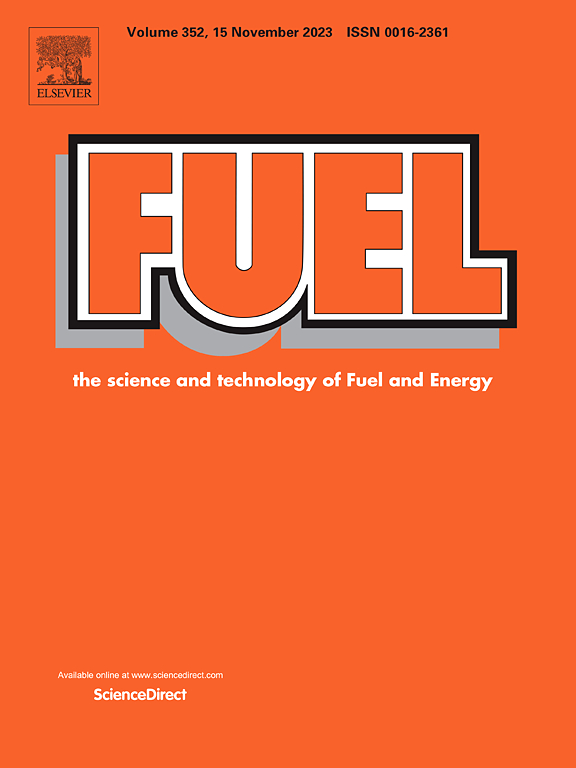Char reduction and producer gas quality enrichment of rice husk by co-gasifying tyre waste in downdraft gasifier
IF 6.7
1区 工程技术
Q2 ENERGY & FUELS
引用次数: 0
Abstract
Energy conversion systems efficiently utilize vast amounts of energy, but also generate significant waste, necessitating waste minimization to reduce processing costs, improve efficiency, and promote resource conservation. This study aims to decrease char waste generated during rice husk (RH) gasification by using tyre rubber (TR) in co-gasification and to improve gasification quality. Investigations are conducted using various blending ratios (BR) of TR to RH (BR: 0–50 %) and gasifier equivalence ratios (ER) (ER: 0.2–0.4) to examine the impact of TR content on gasifier performance and char yield. The gasification temperature rises from 953 °C to 1129 °C for the addition of TR with RH and provides a better gasification result than an increase in ER. The increase in TR content reduces fuel consumption whereas it is found to increase with the increase in ER. The producer gas (PG) yield increases with an increase in TR content, reaching a maximum of 47.1 Nm3/h for BR50 at 0.4 ER whereas it is 37.9 Nm3/h for RH (BR0). The concentration of the combustible gases H2 and CH4 rises when TR is added, but the CH4 gas exhibits a downward trend after 30 % of TR content. Since there is an optimal concentration of combustible gas for each component at about 0.3 ER, 0.3 ER is determined to be appropriate for co-gasifying TR with RH. The increase in TR reduces the char yield however at the optimum ER of 0.3, 30.6 % of char reduction is observed. More char reduction is discovered in the least ER, though, and this is unsuitable when additional performance parameters are taken into account at lower ER. It is found that the TR content in the feedstock increases the efficiency of carbon and hydrogen conversion. Therefore, adding TR to the gasifier to co-gasify rice husk improves environmental sustainability by increasing performance and reducing char. This also lowers the generation of waste tyres.
能源转换系统可有效利用大量能源,但同时也会产生大量废物,因此有必要尽量减少废物,以降低加工成本、提高效率并促进资源保护。本研究旨在通过在共气化过程中使用轮胎橡胶(TR)来减少稻壳(RH)气化过程中产生的炭废物,并提高气化质量。研究采用不同的轮胎橡胶与稻壳(RH)的混合比(BR:0-50%)和气化炉当量比(ER:0.2-0.4)来考察轮胎橡胶含量对气化炉性能和产炭量的影响。在添加 TR 和 RH 时,气化温度从 953 °C 升至 1129 °C,气化效果优于 ER 的增加。TR 含量的增加降低了燃料消耗,而 ER 含量的增加则增加了燃料消耗。生产气(PG)产量随着 TR 含量的增加而增加,在 0.4 ER 条件下,BR50 的最大产量为 47.1 Nm3/h,而 RH(BR0)的产量为 37.9 Nm3/h。加入 TR 后,可燃气体 H2 和 CH4 的浓度上升,但 CH4 气体的浓度在 TR 含量达到 30% 后呈下降趋势。由于每种成分的最佳可燃气体浓度约为 0.3 ER,因此确定 0.3 ER 适合于 TR 与 RH 共气化。TR 的增加降低了炭产量,但在 0.3 的最佳 ER 值下,观察到 30.6% 的炭减少量。但在最小 ER 条件下,焦炭减少量更多,如果考虑到较低 ER 条件下的其他性能参数,则不适合采用这种方法。研究发现,原料中的 TR 含量可提高碳和氢的转化效率。因此,在气化炉中添加 TR 以对稻壳进行联合气化,可通过提高性能和减少焦炭来改善环境的可持续性。这也减少了废轮胎的产生。
本文章由计算机程序翻译,如有差异,请以英文原文为准。
求助全文
约1分钟内获得全文
求助全文
来源期刊

Fuel
工程技术-工程:化工
CiteScore
12.80
自引率
20.30%
发文量
3506
审稿时长
64 days
期刊介绍:
The exploration of energy sources remains a critical matter of study. For the past nine decades, fuel has consistently held the forefront in primary research efforts within the field of energy science. This area of investigation encompasses a wide range of subjects, with a particular emphasis on emerging concerns like environmental factors and pollution.
 求助内容:
求助内容: 应助结果提醒方式:
应助结果提醒方式:


